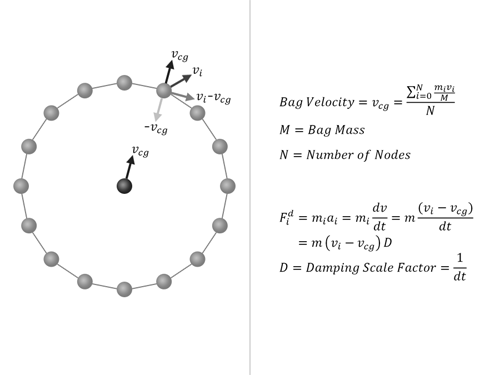When simulating airbag deployment, using the classical uniform-pressure (CONTROL VOLUME) or non-uniform-pressure (ALE, Particle), users frequently encounter oscillations. These oscillations are generally categorized as local and global. To reduce both forms of oscillations, LS-DYNA provides two types of damping that are briefly discussed here.
1. Mass-Weighted-Damping
The parameter MWD in *AIRBAG_{OPTION} keyword provides a means to introduce Mass-Weighted-Damping that is applied to the airbag nodes that make up the airbag. By default, no damping is associated with the airbag nodes. When MWD is nonzero, LS-DYNA determines a nodal damping force that is based on the relative bag velocity, mass, and the MWD parameter. This damping force is computed every cycle and is applied to each node that belongs to the airbag. The bag velocity is defined as the mass-weighted average velocity (see figure below) and the MWD parameter is based on Alembert’s principle. As it can be seen in the figure, MWD can be thought of as being equivalent to a some fraction of the inverse of the global simulation timestep and its value is usually based on the amount of oscillations observed in the model. The best value of MWD is one that critically damps the oscillations and can be computed based on the lowest natural frequency (2*Lowest_Frequency). Since the oscillations are observed usually in the fully-deployed state, estimating its lowest natural frequency requires an intermittent eigenvalue extraction. Intermittent eigenvalues can be extracted by first deploying the airbag using traditional Explicit solution and then switching “intermittently” to Implicit solution method to extract the necessary eigenvalues/eigenvectors at any user-defined time which in this case could correspond to the fully deployed state. Intermittent eigenvalues can be invoked using IMGLAG parameter in *CONTROL_IMPLICIT_GENERAL (see the post Intermittent Eigenvalue Extration). If intermittent eigenvalue extraction is not possible, then a good number is roughly 0.01-0.1% of the inverse of the global timestep. Mass based damping affects rigid body motion and is effective for low frequency noise. It must be noted that MWD is unit dependent (1/Time_Unit).
2. Stiffness Damping
In addition to the mass-weighted damping described above, stiffness based damping can be applied to each element of the airbag material using the DAMP parameter if the airbag material is modeled using *MAT_FABRIC material model. A default value of 0.05 (which is equivalent to 5% critical damping) is used by LS-DYNA. Stiffness based damping are orthogonal to rigid body motion (do not affect rigid body motion) and is effective in high-frequency oscillations. In some instances values larger than the default value of 5% may be necessary depending on the problem in which case a lower timestep may be necessary.















